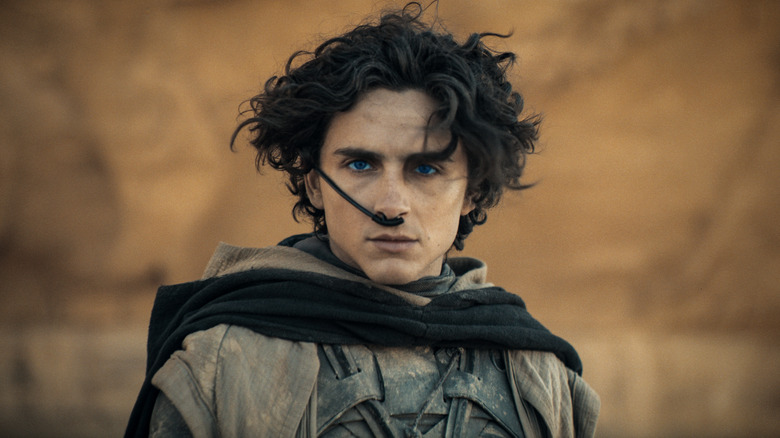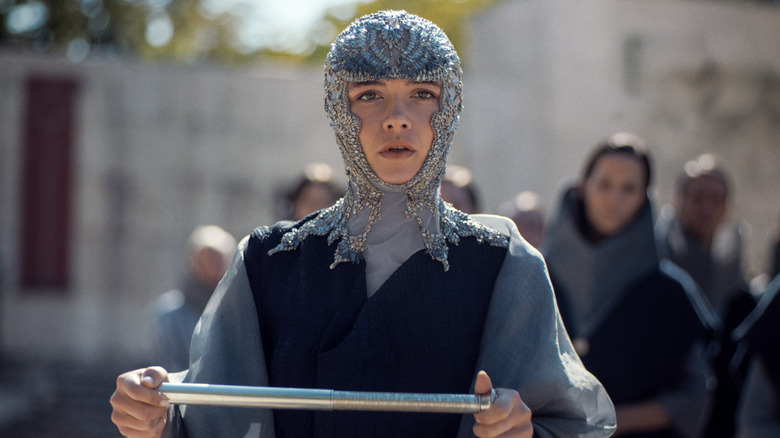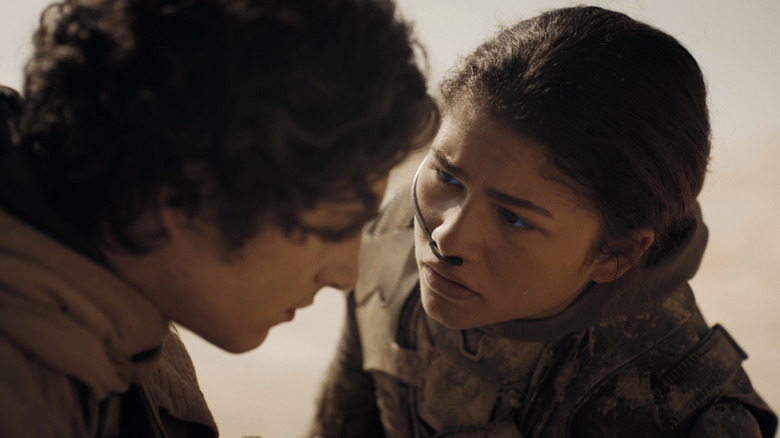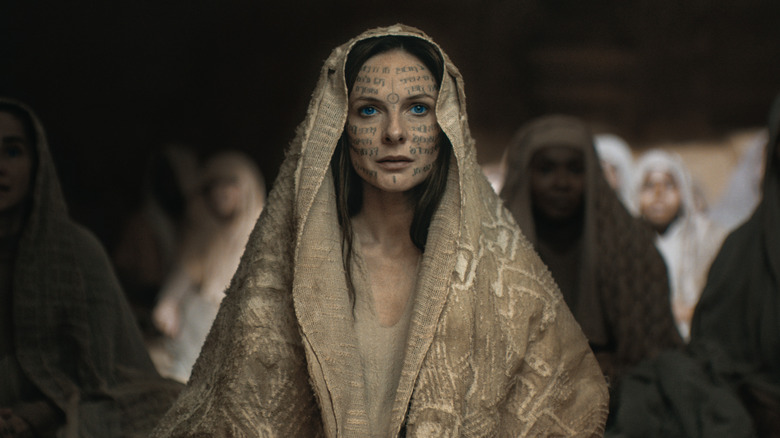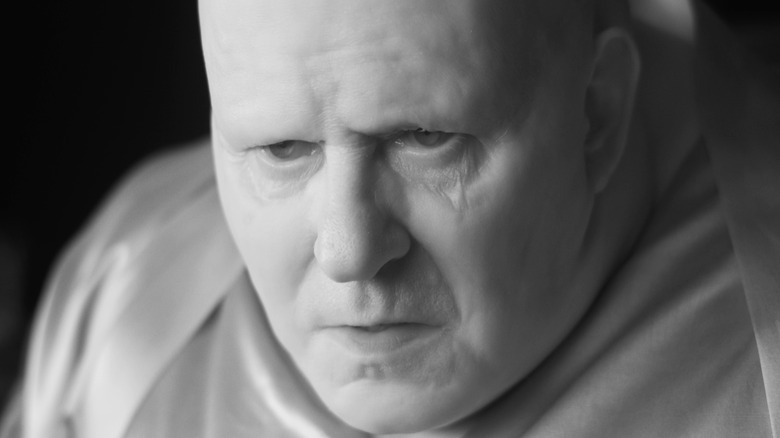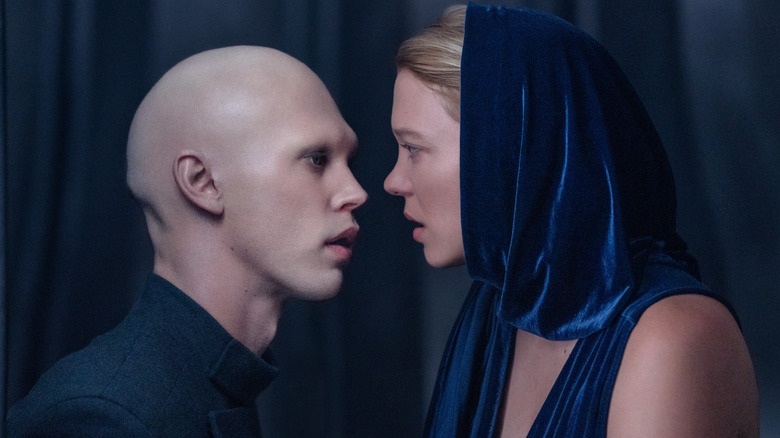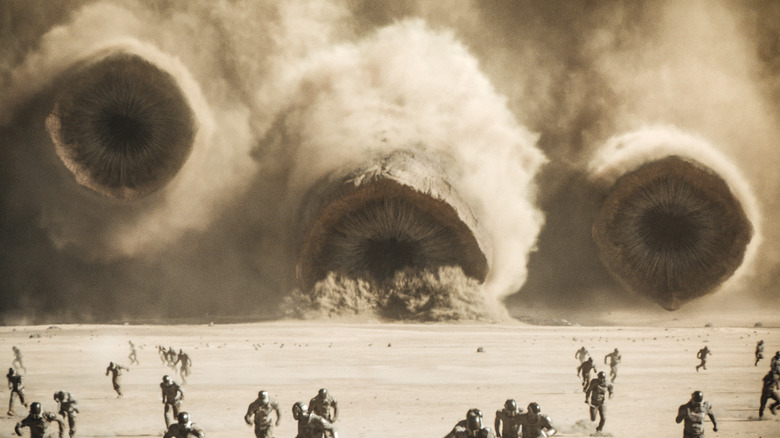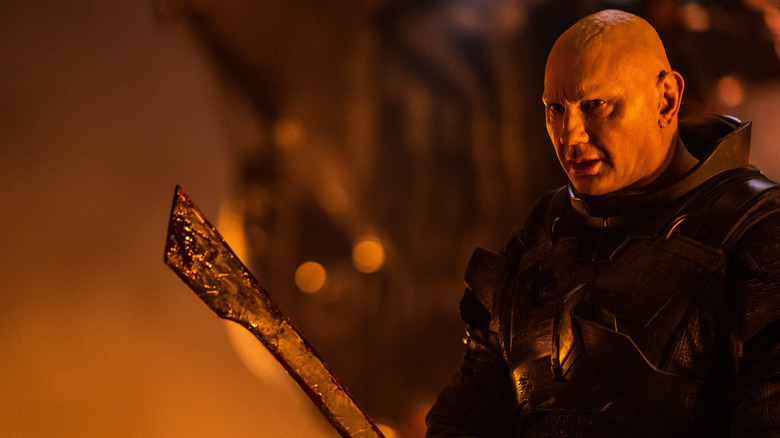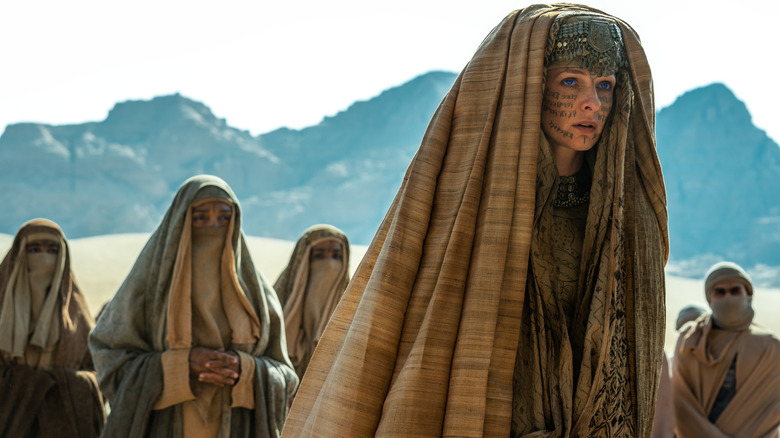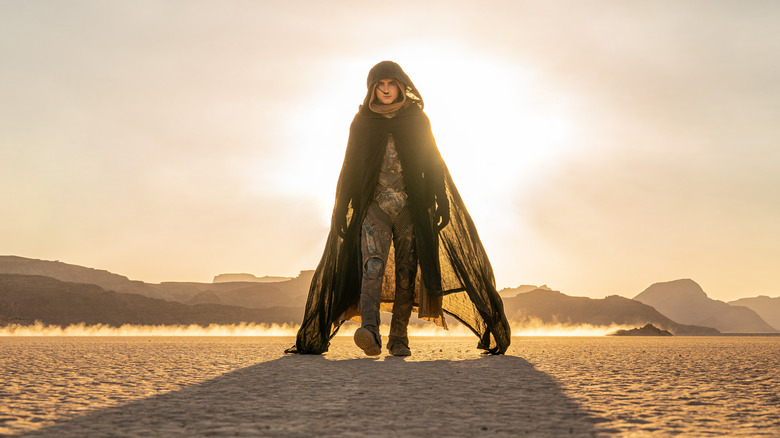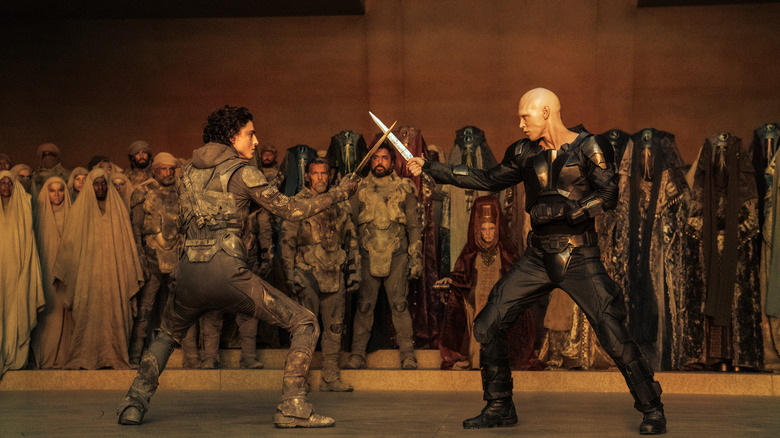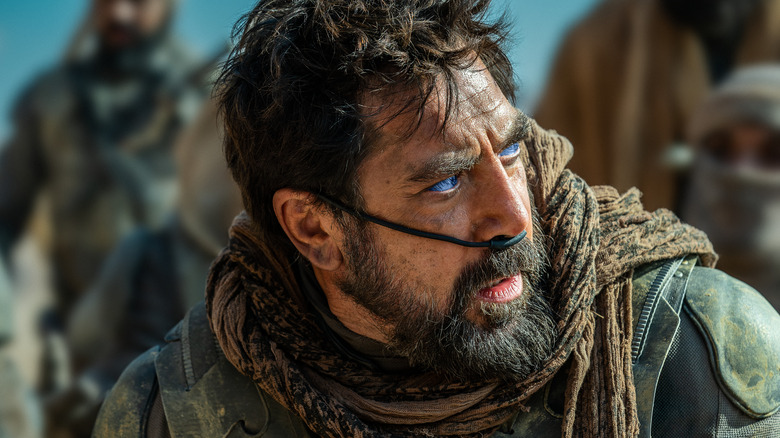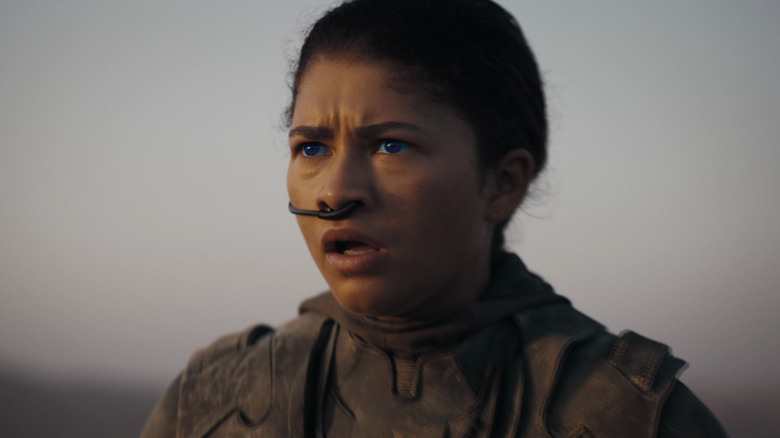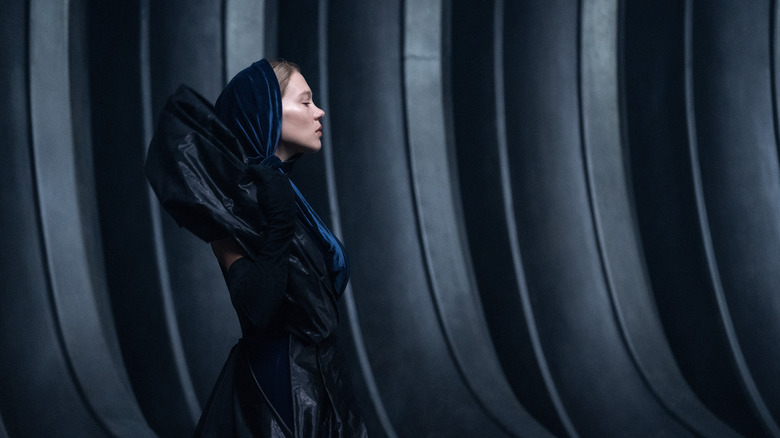Small Details You Missed In Dune Part 2
Contains spoilers for "Dune: Part Two"
For years, many people said that Frank Herbert's "Dune" was impossible to adapt. It was too weird, too beloved, and past attempts were either never completed or released to general mockery. But with the second half of Denis Villeneuve's adaptation, "Dune: Part Two," now out, that old way of thinking is gone forever. Across the two films and more than five hours of runtime, Villeneuve has created an adaptation that seems destined to stand the test of time.
Like Peter Jackson's "The Lord of the Rings" films, this new "Dune" duology presents a definitive visual version of its adored source material. And, like "The Lord of the Rings," it's an ideal subject for repeat viewings. "Dune: Part Two" is full of small details you might miss on your first time through, from Easter eggs referencing the book to clever parallels between the characters. Herbert's novel is rich with symbolism and thematic connectivity, and "Dune: Part Two" follows suit, pairing a menagerie of stunning shots and sci-fi vistas with an intricately woven story.
The scale of the film is so massive that it's easy to miss some of the finer details on your first watch, so these are things you may not have noticed in "Dune: Part Two."
Irulan's narrations pay homage to the novel
"Dune: Part Two" opens with expository narration from Princess Irulan (Florence Pugh). She catches viewers up on the events of the first film — in particular, the destruction of House Atreides by House Harkonnen and her father, Emperor Shaddam IV (Christopher Walken). If you've read the novel, this opening narration will immediately evoke the epigraphs that begin each chapter, each of which is pulled from historical texts written by the princess.
In other words, Herbert's "Dune" is loaded with excerpts from Irulan's writings — accounts of Paul (Timothée Chalamet) and Arrakis written after the events of the book. She spends much of her life as a writer and historian, and it's fun to see this aspect of her character included in "Dune: Part Two." We're shown at the very start of the movie that she's interested in the larger goings-on of galactic history, foreshadowing the critical role she'll play in chronicling it. And since Irulan doesn't appear at all in the first "Dune" movie, beginning "Part Two" with one of her citations is a great move for longtime fans of the novels.
What does Chani's blue ribbon mean?
Throughout much of "Dune: Part Two," Chani (Zendaya) wears a blue ribbon in her hair. Later, during battle scenes especially, you can see it wrapped around the arm of her stillsuit. Its bright hue stands out against the matte colors of most Fremen clothing and the desert itself, but what does the ribbon actually represent?
This accessory appears to be a Nezhoni scarf — an item in the novel that's worn by Fremen women who are married or otherwise romantically committed, and who have given birth to a son. In the book, Paul and Jessica (Rebecca Ferguson) live among the Fremen for years in the desert, whereas "Dune: Part Two" spans less than a year. This shortened timeline cuts out some arcs from the novel, including one in which Paul and Chani have a son named Leto II.
Leto II is killed while still just an infant in the novel, the victim of an attack by his father's enemies. Giving Chani the blue scarf in the movie could be a nod to this storyline, as book fans will surely identify it and remember its significance. Some have theorized that the Leto II arc was planned but cut from the movie, but that seems unlikely, as there isn't enough time for Chani to get pregnant and give birth. Instead, the scarf seems to represent her relationship with Paul in the movie — one that becomes increasingly distant in the final act.
Where is Alia of the Knife?
If you're a fan of Frank Herbert's "Dune," then you probably had one big question about "Dune: Part Two": How would the movie handle Paul's younger sister, Alia? In the book, about five years pass between the death of Duke Leto Atreides (Oscar Isaac) and Paul's victory over the Harkonnens and Emperor Shaddam IV. Alia is four years old in the climactic battle of the first novel, and as a fully conscious mind with centuries of knowledge — thanks to being exposed to the Water of Life in utero — she's already a competent leader, referred to for her viciousness as "Alia of the Knife."
Creating a convincing four-year-old murder princess with deep cosmic knowledge is no easy feat for a live-action movie. To avoid this dilemma, "Dune: Part Two" truncates Paul's desert chapter to less than nine months, allowing Jessica to stay pregnant for the whole movie. Alia persists as a vocal agent in the plot, but she does so from within her mother's womb. In one scene, though, we do see her appear to Paul as an adult woman, played by Anya Taylor-Joy.
If you haven't read the books, this all may be a bit confusing. Alia is incredibly important in "Dune Messiah" and "Children of Dune," and because she possesses powers of prescience similar to Paul's, she's able to commune with him both cognitively and out of time. Both siblings exist on a shared frequency of future-sight, and Alia's brief onscreen cameo foreshadows a much larger role in the potential sequel.
The Harkonnen black sun has its own significance
"Dune: Part Two" mostly takes place on Arrakis, but it does visit a couple of other planets, including the Harkonnen homeworld of Giedi Prime. In the novel, the planet is described as being incredibly industrialized, to the point that the natural ecosystem is in decline. Villeneuve and his team take things a step further in the movie version by making Giedi Prime literally a black and white world.
The distinctive color choice is explained briefly in a line just before Feyd-Rautha Harkonnen (Austin Butler) enters the gladiator's arena for his big fight. The announcer mentions that Giedi Prime has a "black sun," which paints the whole world in stark, brutalist grayscale. This is both a genius bit of sci-fi flavor and a perfect symbol of the Harkonnens' worldview. They live in and perpetuate a cold, violent culture. Their military mobilizes in scenes that evoke real-world fascist imagery, and they deploy airstrikes and drone warfare against the Fremen instead of fighting fair.
"The idea came from the book," Villeneuve told Moviefone. "The book is a study of the impact of the ecosystem on human beings, all from the nature of the ecosystem ... we are the product of our environment." By using infrared filming techniques, the director was able to establish a uniquely harsh ecosystem on Giedi Prime. "What if instead of revealing colors, the sunlight was killing them and creating a very eerie black and white world, that will give us information about how these people perceive reality, about their political system."
Feyd-Rautha also has future-sight
Feyd-Rautha Harkonnen is the classic literary foil — a match for Paul Atreides in every way, but with a dark, bizarro spin. The parallels between them aren't just symbolic, either. Part of the grand Bene Gesserit plan is keeping multiple candidates for Kwisatz Haderach active at once. They don't plan for their prescient superperson to be Paul Atreides, and it's clear that they have other options on the table, including Feyd-Rautha.
One blink-and-you'll-miss-it hint at this occurs when the Bene Gesserit named Margot Fenring (Léa Seydoux) seduces Feyd and administers the Gom Jabbar test. In their initial confrontation, Feyd says that he dreamed about her the night before, despite them never having met. Like Paul, Feyd possesses a level of future-sight. Had he been raised with the same Bene Gesserit training and Mentat conditioning that Paul received throughout his life, it's possible that he could even achieve similar powers through extended spice exposure.
The existence of an alternate path drives home just how fragile Paul's prophecy actually is. He sees the future, yes, but he also gets lucky. In the world of "Dune," prophecies are crafted for political gain. This little glimpse of Feyd-Rautha's prescience emphasizes that one little misstep could lead things in a drastically different direction.
How worm-riding actually works
One of the big set pieces in "Dune: Part Two" is Paul's first sandworm ride — a major moment in the book that's translated beautifully to the big screen. The sequence is recreated perfectly, but if you haven't read the original version, you may not recognize everything that's going on.
Sandworm riding is explained in great detail in the book. The hooks that Paul and the Fremen use aren't just for steering or holding on, but for keeping the worm above ground. The hooks are designed to latch onto individual plates of the worm's exoskeleton, prying them open to expose the softer parts underneath. Such an opening makes the worm vulnerable to irritation from the sand, so it instinctively rotates to keep the open plate on top, as far away from the sand as possible. This naturally positions the rider in a spot where they can stand, leverage more hooks, and begin to steer the worm more actively. And because the plate stays open during the ride, this process also ensures that worms won't try to go back underground while a Fremen is atop them.
Rabban vs. Gurney is more than just a fight
One of the smaller plotlines in "Dune: Part Two" is the rivalry between Glossu Rabban Harkonnen (Dave Bautista) and Gurney Halleck (Josh Brolin). We glean in bits and pieces over the two movies that Gurney doesn't just hate Rabban because he hates Harkonnens, though that's part of it. Rabban killed his sister when she and Gurney were slaves on Giedi Prime. To Gurney, he represents all the brutality and viciousness of the Harkonnens, and it's only appropriate that such a loyal servant of House Atreides would be the one to kill Rabban.
At the same time, this confrontation feels small by the time it actually happens. It's satisfying to see Gurney finally get his revenge, but as he kills Rabban, the fires of war burn around them. Paul's Fremen warriors charge into battle, and while Gurney's vendetta is quenched, the holy war is just beginning. This moment is strangely melancholic. It marks the end of the longstanding feud between the Harkonnens and the Atreides, but the start of a much more violent conflict.
Worm lore and the Water of Life
One thing that Denis Villeneuve's "Dune" movies gloss over a bit is how the whole Arrakis ecosystem actually works. The first movie reveals that terraforming efforts stopped after the discovery of spice, but we don't get the same expansive explanation that the book provides. "Dune: Part Two" also provides some tidbits about how the worms work, but it isn't laid out explicitly.
In the film, we see that the Water of Life is actually extracted from young sandworms. It's a biological fluid of some sort. The reason it carries similar prescient powers to spice is that sandworms themselves are critical pieces of the spice-growing process. The lifecycle of worms is explored more in Frank Herbert's later books.
We also see in "Dune: Part Two" that water is lethal to the sandworms. Though this is never said out loud, we see it in practice. The delicate ecosystem of Arrakis creates a harsh cycle by which spice is perpetually generated. However, this process also prohibits the planet from being made more habitable for humans.
The death of Paul Atreides
"Dune" is really a tragedy at its core. It's the story of a young man pushed into a violent future by forces beyond his control. "Dune: Part Two" is different from the first movie in a lot of ways because it tells a very different part of the story. It's the saga of Paul's rise as a leader amongst the Fremen, but also of his fall. For most of the movie, Paul resists going south. In all of his visions, that trip leads to the holy war he fears — a galactic wave of bloodshed fought in his name by zealots beyond his ability to control. Yet he goes anyway, seeing no alternative.
One detail you might not have noticed is that Paul is shown very differently after he drinks the Water of Life. Before that, there are tons of scenes showing him in intimate moments. Like Chani, we see the real Paul — the private person, not the public figure. But we never get another moment like this after he wakes up from his coma. Instead, we only see him as his followers see him — as a bold leader without a shred of doubt. And like Chani at this stage, we don't get access to his inner convictions. "You'll never lose me," she tells him at one point, "as long as you stay who you are." But Paul Atreides dies in the end, and the Kwisatz Haderach rises.
Feyd the foil
One of the reasons why "Dune: Part Two" blew everyone away at the box office is that it added even more stars to the first film's already impressive cast. Putting Austin Butler opposite Timothée Chalamet in the role of Feyd-Rautha was a brilliant move because, while the character is sadistic and evil at every turn, Butler also brings a level of dark charisma that mirrors Paul.
The two have a lot of little parallel moments in their journeys. When Feyd takes over Arrakis from Rabban, he insists that his older brother kiss his feet. At the end of the film, Paul makes a similar command of the old emperor by ordering him to kiss his ducal signet ring. It's revealed that Paul and Feyd themselves are cousins, as Jessica's father is none other than Baron Vladimir Harkonnen (Stellan Skarsgård).
Feyd-Rautha meets his end in another mirror moment. At the end of his knife fight with Paul, Feyd gains the upper hand, sticking his own blade into Paul's side and approaching his enemy for the killing blow with the knife he dropped. When Feyd goes in for the final blow, though, Paul catches him on his knife, which he seems to pull out of himself without Feyd noticing. They pull apart to reveal parallel wounds, but Paul's is just barely non-lethal. It's a final reminder of just how narrow Paul's path to victory is, and it's only appropriate that the duel ends with identical attacks.
Lead them to paradise
Throughout the last act of "Dune: Part Two," it's clear that Paul has changed. The Water of Life fully activates his Kwisatz Haderach powers, and whatever it is he sees with them convinces him that war is necessary. It's tragic because he fights so hard for most of the movie to resist this future. He hates that his mother has set him on the path to prescience, and he hates the idea of a crusade being fought in his family's name. Even as the final battle rages, you can convince yourself that Paul's behavior is reluctant. He has to defeat the Harkonnens because they're evil, and he must assume the imperial throne to maintain order. Maybe he'll be able to find another answer besides galactic war. He just needs to take back Arrakis first and figure things out.
But then, after defeating Feyd-Rautha, Paul is informed that the other great houses refuse to bow to his rule. Stilgar (Javier Bardem) asks what he'd have the Fremen do, and Paul's answer is simple: "Lead them to paradise." It's a sinister, chill-inducing line. Not only is he playing on the language of the prophecy to compel the Fremen, but there's clear malice in his voice. He knows he's directly ordering the murder of millions, perhaps billions. But he doesn't waste a second trying to negotiate a more peaceful result. It's just four words, but they tell us and Chani that the old Paul truly is gone.
The final shot foreshadows what's to come
Though Paul is the protagonist of "Dune: Part Two," the film closes on Chani. After he orders his Fremen to begin a war with the other great houses, they storm the ships and fly off to do his bidding. Rejecting this, Chani leaves him, departs Arrakeen, and wanders back into the desert to call a worm. The movie ends with a shot of Chani's face staring down the coming beast. Sand and dust kick up into the sky, but she stands her ground. You can see her chin shaking, but like a good Fremen, she holds back her tears. She doesn't give up her water despite seeing the man she loves turn into a tyrant.
Throughout the film, Paul has numerous visions, and they don't all come true. Things happen similar to how he foresees them, but not exactly the same way. The future, it seems, is not set, even for those who can see it. Prescience promises immense power, but that doesn't mean that it's absolute.
Chani's vision at the end is much clearer. The image of the worm bearing down on her, standing with her legs braced and her hooks out, is indicative of everything that's coming. She knows the violence that will be perpetrated in Paul's name and at his command. Yet tragically, all she can do is stare it down and wait, hoping that her people can endure it.
Book changes and sequel set-ups
"Dune: Part Two" makes some big changes to the source material, diverging markedly more from the book than the first film. The timeline is shrunken, Alia isn't born by the end, and we don't get to see as much of day-to-day Fremen culture, like how Paul has to take care of Jamis' wife in the book. He and Chani don't have a son in the movie either.
One of the biggest changes is the complete absence of Thufir Hawat (Stephen McKinley Henderson), the Mentat of House Atreides. In the novel, Thufir survives the Harkonnen betrayal and is taken captive, forced to use his strategic abilities to fight against the Fremen. He tries to take down the evil family from within and ultimately dies tragically at the end of the book. In "Dune: Part Two," there is no mention of Thufir, and he does not appear, although Henderson did film scenes for the movie that did not make the final cut.
There are also some book Easter eggs in "Dune: Part Two" that could play into the possible sequel — a film that hasn't been officially ordered yet, but which Denis Villeneuve is already working on. The preservation of the Harkonnen bloodline through Margot Fenring's seduction of Feyd-Rautha could come back in a big way, and Anya Taylor-Joy's Alia cameo could be just the beginning of her story. Fans maybe shouldn't expect "Dune 3" anytime soon, but if it does come, it has a lot already going for it.
